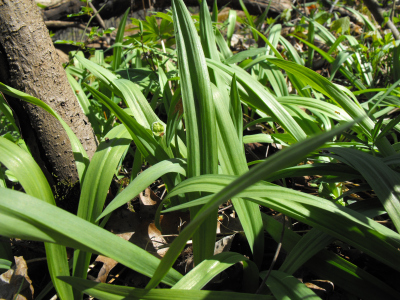
Ramps in the forest garden
 Ramps
are a prime candidate for forest
gardening.
They are an early
spring ephemeral that will keep nutrients cycling through the soil
before trees leaf out, they prefer growing in shady spots under
deciduous trees, and they are considered a delicacy by many. Once
a patch gets going, it can outcompete other herbs and turn into a solid
groundcover, as this photo from the wild shows.
Ramps
are a prime candidate for forest
gardening.
They are an early
spring ephemeral that will keep nutrients cycling through the soil
before trees leaf out, they prefer growing in shady spots under
deciduous trees, and they are considered a delicacy by many. Once
a patch gets going, it can outcompete other herbs and turn into a solid
groundcover, as this photo from the wild shows.
There are two species of
ramps in our area --- the stereotypical Allium
tricoccum and the
slightly smaller Allium
burdickii,
sometimes known as Burdick's wild leek. I know spots where both
of these grow, but the latter is found at a lower elevation in
conditions more like those in my garden, so I thought I'd give it a
shot first.
I'd prefer to plant
ramps from seeds, but the fruits are difficult to find in the wild, so
I dug a few seedlings from the edges of a wild clump. When
digging wild plants, I never take more than 10% of a population
(preferably much less), and try to remove plants that are already
threatened in some way. The plants I dug were in the middle of a
trail and were already damaged by hiking boots, so I figure they'll
have a better chance in my garden than if left in place in the woods.
My Burdick's wild leeks
have found a new home nestled amid the leaf mold under my oldest peach
tree. If this experiment works, I may try for some Allium
trioccum in a few
weeks when the higher elevation plants are out. I hope to expand
the clump by seed once the ramps become established, and to begin to
harvest leaves in a few
years.
For more information about ramp cultivation, check out this extension
service factsheet.
To see the masses of wildflowers I stumbled across during my ramp hunt,
visit my Appalachian ecology site.
Want more in-depth information? Browse through our books.
Or explore more posts by date or by subject.
About us: Anna Hess and Mark Hamilton spent over a decade living self-sufficiently in the mountains of Virginia before moving north to start over from scratch in the foothills of Ohio. They've experimented with permaculture, no-till gardening, trailersteading, home-based microbusinesses and much more, writing about their adventures in both blogs and books.
Want to be notified when new comments are posted on this page? Click on the RSS button after you add a comment to subscribe to the comment feed, or simply check the box beside "email replies to me" while writing your comment.
